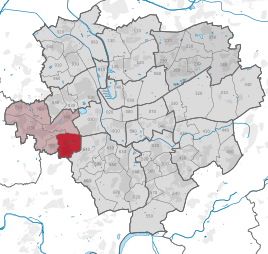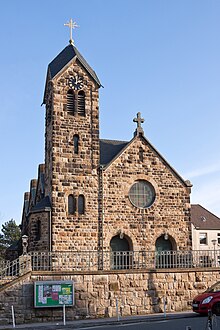Oespel
|
Oespel
City of Dortmund
Coordinates: 51 ° 29 ′ 11 ″ N , 7 ° 22 ′ 55 ″ E
|
|
|---|---|
| Height : | approx. 120 m above sea level NHN |
| Area : | 4.15 km² |
| Residents : | 4250 (Dec. 31, 2019) |
| Population density : | 1,024 inhabitants / km² |
| Incorporation : | April 1, 1928 |
| Postcodes : | 44149, 44227 |
| Area code : | 0231 |
| Statistical District : | 75 |
|
Location of Oespel in Dortmund
|
|
Oespel is the statistical district 75 and at the same time a western part of the city of Dortmund . It is located in the Lütgendortmund district . The resident population of Oespel was 4,250 in 2019.
In contrast to some other Westphalian place names, Oespel's "Oe" is normally spoken with a short Ö-umlaut ( Öspel instead of incorrectly Ohspel ), especially since the name of the place was previously written as Öspel .
geography
Oespel is about six kilometers west to southwest of Dortmund city center. The town is bordered by the districts of Kley , Marten , Dorstfeld , Barop and Eichlinghofen and in the south by the Witten district of Stockum .
In the south of the village there is an extensive wooded area, the Dorney , the adjoining residential area Oespels is characterized by single-family houses. In the northeast, the growing Dortmund Technology Park is approaching the Oespeler residential development. In this area of Oespels there are mostly small apartment buildings.
The construction of the S-Bahn line 1 between Dortmund and Düsseldorf changed the townscape. The S-Bahn runs through Oespel as an elevated railway on concrete stilts and has thus divided the grown town center since the early 1980s. The Dortmund-Oespel stop on the Witten / Dortmund – Oberhausen / Duisburg railway line is now in the center of the village .
history
The first settlement of the Oespeler local area can be dated to the Bronze Age. After the Second World War, some urn graves were first discovered in a field. In a new excavation in 1991, a total of 28 barrows were found in which cremation remains in urns and isolated grave goods were found. Among other things, a small iron ball was discovered in a grave, which is the oldest iron find in the Ruhr area .
Today's Oespel district is much more recent. In lifting registers of Werden Abbey to documents about the year found 880 a peasant named Tospelli, today Oespel show. The name Oespel appears for the first time in the 16th century. The coat of arms of Oespel, which shows two crossed pitchforks, was first documented in 1357.
The rural character of the village of Oespel only changed with the onset of industrialization . The coal seams that emerged there have always been exploited in the Dorney forest. The first underground mines were then built around 1850. There were a total of four mines in the Oespel area: the Borussia colliery , later renamed the Oespel colliery , the planet field colliery , the Im white field colliery and the Oespel II colliery . The last mines to be shut down were Oespel and Oespel II in 1962.
The Indupark Oespel was created on the areas of the Oespel colliery that are now available. Originally conceived as an industrial area, today you can almost exclusively find large retailers such as Hellweg Baumarkt , Ikea , Mövenpick -Weinland, the Indupark Center and the Staples office supply chain .
On April 1, 1928, Öspel (the spelling of the place at that time) was incorporated into Dortmund.
population
Structure of the population in Oespel:
- Share of the population under 18 years of age: 14.5% [Dortmund average: 16.2% (2018)]
- Population share of at least 65-year-olds: 22.3% [Dortmund average: 20.2% (2018)]
- Proportion of foreigners: 7.7% [Dortmund average: 18.8% (2019)]
- Unemployment rate: 4.9% [Dortmund average: 11.0% (2017)]
The average income in Oespel is around 10% above the Dortmund average.
Population development
| year | 1987 | 2003 | 2008 | 2013 | 2016 | 2018 |
|---|---|---|---|---|---|---|
| Residents | 4150 | 4491 | 4316 | 4307 | 4355 | 4257 |
Nature reserve
Since 2004, the zoning plan of the city of Dortmund has designated the Dorney Forest, which is partly in Oespel, with an area of 40.4 hectares as a nature reserve . The official name is "Nature reserve No. 25, - Lütgendortmund district" ( see also : Dorney ).
Personalities
- August Schmidt (1878–1965), co-founder of IG Bergbau und Energie and its first chairman, born in Dortmund-Oespel
- Heinrich Göckenjan (1900–1986), German politician (NSDAP), worked as a farmer at Winkelmannshof in Dortmund-Oespel before 1943
- Otto Dannebom (1904–1975), German trade unionist and politician (SPD), chairman of the shaft group at the Oespel colliery
- Luise Peter , b. Radtke (1906–1979), German politician (SPD), born in Dortmund-Oespel
- Franz Kurowski (1923–2011), German author, lived in Dortmund-Oespel
- Reinhard Libuda (1943–1996), German soccer player, lived temporarily in Dortmund-Oespel before and after moving to Borussia Dortmund
Web links
Individual evidence
- ↑ Population figures in the statistical districts on December 31, 2019 (PDF)
- ↑ Rudolf Kötzschke (Ed.): Die Urbare der Abtei Werden ad Ruhr (= Publications of the Society for Rhenish History XX: Rheinische Urbare ). Vol. 2: A. The land register from 9. – 13. Century, ed. by Rudolf Kötzschke, Bonn 1908, reprint Düsseldorf 1978; Vol. 3: B. Stock books, lifting and interest registers from the 14th to the 17th century, Bonn 1908, reprint Düsseldorf 1978; Vol. 4, I: Introduction and Register, I. Name Register , ed. by Fritz Körholz, Düsseldorf 1978; Bd. 4, II: Introduction, Chapter IV: The economic constitution and administration of the large manor in Werden, subject register, ed. by Rudolf Kötzschke, Bonn 1958.
- ↑ Stephanie Reekers: The regional development of the districts and communities of Westphalia 1817-1967 . Aschendorff, Münster Westfalen 1977, ISBN 3-402-05875-8 , p. 270 .
- ↑ Population share of the under 18 year olds Statistical Atlas 2019 (PDF file)
- ↑ Population share of at least 65-year-olds Statistical Atlas 2019 (PDF file)
- ↑ Nationalities in the statistical districts on December 31, 2019 (PDF file)
- ↑ Unemployment rates by statistical district on June 30, 2017 (PDF file)
- ↑ Emergency in football - the business with the Bundesliga. Der Spiegel, issue 28/1965 of July 7th, 1965: That's terrible .



